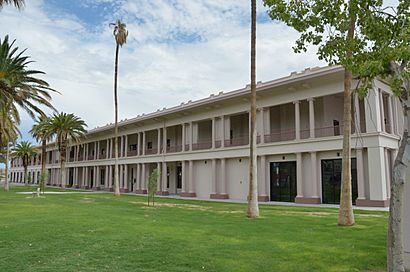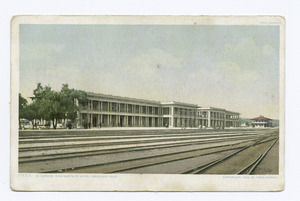El Garces Intermodal Transportation Facility facts for kids
Quick facts for kids
Needles, CA
|
|||||||||||||
|---|---|---|---|---|---|---|---|---|---|---|---|---|---|

El Garces Intermodal Transportation Facility in July 2014
|
|||||||||||||
| Other names | El Garces Intermodal Transportation Facility | ||||||||||||
| Location | 950 Front Street Needles, California United States |
||||||||||||
| Coordinates | 34°50′27″N 114°36′20″W / 34.84083°N 114.60556°W | ||||||||||||
| Owned by | City of Needles/BNSF Railway | ||||||||||||
| Line(s) | BNSF Southern Transcon (Needles Subdivision, Seligman Subdivision) | ||||||||||||
| Platforms | 1 side and 1 island platform | ||||||||||||
| Tracks | 3 | ||||||||||||
| Connections | |||||||||||||
| Construction | |||||||||||||
| Parking | Yes | ||||||||||||
| Other information | |||||||||||||
| Station code | Amtrak: NDL | ||||||||||||
| History | |||||||||||||
| Opened | 1908 | ||||||||||||
| Traffic | |||||||||||||
| Passengers (FY2019) | 8,641 (Amtrak) | ||||||||||||
| Services | |||||||||||||
|
|||||||||||||
|
|||||||||||||
|
El Garces
|
|||||||||||||
| Location | Needles, California | ||||||||||||
| Built | 1908 | ||||||||||||
| Architect | Francis W. Wilson | ||||||||||||
| Architectural style | Classical Revival | ||||||||||||
| NRHP reference No. | 02000537 | ||||||||||||
| Added to NRHP | May 17, 2002 | ||||||||||||
The El Garces Intermodal Transportation Facility is a cool historic building in Needles, California. It's also known as Needles station. Today, it serves as an Amtrak train station and a bus stop.
This building was first opened in 1908. It was called El Garces back then. It was a special kind of hotel and restaurant called a Harvey House. It also served as a train station for the Atchison, Topeka and Santa Fe Railway (ATSF).
The building got its name from Francisco Garcés. He was a Spanish missionary who explored the area in the 1770s. Because of its history, El Garces was added to the National Register of Historic Places in 2002. This means it's an important landmark!
Contents
History of the Needles Train Station
The First Station in Needles
In the 1880s, two big railroad companies were growing fast. These were the Southern Pacific Railroad (SP) and the Atchison, Topeka and Santa Fe Railroad (ATSF). They were both trying to control train routes in the Southwestern United States.
On August 9, 1883, the SP finished its railway line. It stretched from Mojave, California to Needles. There, it connected with the ATSF's Atlantic and Pacific Railroad, which was building west. The first train station in Needles was a simple, one-story wooden building. It was one of the first buildings in the new town.
The ATSF worried that the SP would send trains on its own longer routes. This would make the SP more money. So, the ATSF threatened to build its own line west from Needles. In August 1884, the SP sold its Mojave–Needles line to the Atlantic and Pacific. In 1898, the ATSF added a Harvey House to the station. They also added a second story with hotel rooms for travelers and staff. Sadly, this station was destroyed by a fire on September 6, 1906.
Building the Grand El Garces
After the fire, the ATSF saw a chance to make Needles a popular place for tourists. This would bring more passengers and money to the railroad. They hired architect Francis W. Wilson to design a new station. This new building would combine a train station, a dining room, and a hotel all in one huge structure.
The new building, El Garces, opened on April 3, 1908. It cost about $250,000 to build back then. It was originally 518 feet long and 98 feet wide. Many local Mojave people helped build it. El Garces was made of cast in place concrete. This material helped keep the building cool during hot desert days and warm on chilly nights. It was the first ATSF station built with concrete.
The hotel was named El Garces after Padre Francisco Garcés. He was a Spanish missionary who explored the area in the 1770s.
Most ATSF stations were built in the Mission Revival style. But Wilson designed El Garces in the Classical Revival style. This style was more common in train stations on the East Coast. The unique style made Needles seem modern. It also fit with the Fred Harvey Company's plan to use up-to-date designs.
The ground floor had a lobby, a dining room, a lunch room, a kitchen, and other areas. The second floor had 64 hotel rooms. Both floors had wide porches all around them. El Garces was known as the "Crown Jewel" of the entire Fred Harvey hotel chain. It was staffed by the famous Harvey Girls. Working at El Garces was a very desired job for them.
In 1912, a newsstand replaced the fountain in the main entrance area. The lunch room was updated several times, including in 1922 and 1927. During World War II, El Garces helped feed soldiers traveling on troop trains. Even General George S. Patton visited the hotel often during military exercises in the desert.
However, fewer people traveled by train after the war. Cars and airplanes became more popular for long trips. Because of this, the Harvey Company closed El Garces in 1949.
Changes and Decline
The ATSF railroad still used the building and made changes in the 1950s. The dining room was divided into offices. The kitchen became a baggage room. A modern air conditioning system was also installed. In 1961, the railroad tore down the east part of El Garces. This section used to have a ticket office and other offices. They built a parking lot there instead, making the building shorter.
Even with fewer facilities, trains like the Super Chief and El Capitan still stopped at Needles. This continued until Amtrak took over most long-distance passenger train service in the United States on May 1, 1971. Amtrak kept one train, the combined Super Chief/El Capitan, on the ATSF route. This train was later renamed the Southwest Chief in 1984. It continued to serve Needles.
The ATSF finally left El Garces in 1988. They moved their offices to another building nearby.
Bringing El Garces Back to Life
In 1993, a group called "Friends of the El Garces" was formed. They wanted to save the building from being torn down. A fire in 1995 damaged part of the old kitchen area. In 1999, the city of Needles bought the building from BNSF Railway. This company was the successor to the ATSF. Work to make the building stable was finished in July 2001. El Garces was officially added to the National Register of Historic Places on May 17, 2002.
The city planned to use El Garces for its original purposes again. This meant having a hotel, restaurant, and train station. Construction started on March 7, 2007. The project faced some challenges with funding and ownership.
Eventually, the city received $9 million from the Federal Transit Administration (FTA). They also got $2.4 million from state and county funds. The project then focused on renovating part of the first floor for transportation use. This included services for Needles Area Transit and Amtrak. The $12 million project to create the El Garces Intermodal Transportation Facility was completed in 2014. Amtrak opened a dedicated waiting room for Southwest Chief passengers on May 7, 2016. This room is open during the overnight hours before the train arrives.



